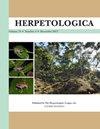山地蝾螈对模拟环境条件的行为反应
IF 1.1
3区 生物学
Q2 ZOOLOGY
引用次数: 0
摘要
摘要:生物体对非生物条件的反应对于预测其对气候变化的反应至关重要。机械模型已被广泛用于根据许多生物体的生理和行为预测其分布和丰度。为了为机械模型预测提供进一步的支持和信息,可以创建相对现实的实验室实验来复制自然气候场景。我们为陆生蝾螈设计了围栏,允许以相对现实的方式操纵非生物条件,并观察地表和地下行为。在一次试验中,围栏提供了真实的条件,准确地反映了我们的研究物种在活跃季节将面临的野外条件。蝾螈对我们围栏内不断变化的非生物条件的行为反应与长期实地研究中观察到的相似。我们的研究还记录了地下行为的差异,年轻和较小的蝾螈在进食后的几天里占据了较浅的深度。鉴于当前气候情景下实验室和野外行为之间的强烈相关性,以及非生物和生物条件之间潜在的未知结果,我们建议使用现实的实验室围栏来复制未来的气候条件,以进一步完善机制模型的预测能力。本文章由计算机程序翻译,如有差异,请以英文原文为准。
Behavioral Response to Simulated Environmental Conditions in a Montane Salamander
Abstract: How organisms respond to abiotic conditions is paramount for predicting their response to climate change. Mechanistic models have been used extensively to predict the distribution and abundance of many organisms based on their physiology and behaviors. To provide further support for, and inform, mechanistic model predictions, relatively realistic laboratory experiments can be created to replicate natural climatic scenarios. We designed enclosures for terrestrial salamanders that allowed for manipulation of abiotic conditions in a relatively realistic way and for observation of both surface and subsurface behaviors. During a trial, enclosures provided realistic conditions that were an accurate reflection of the field conditions that our study species would be exposed to during their active season. Salamanders behaviorally responded to changing abiotic conditions in our enclosures in a similar fashion to what has been observed through long-term field studies. Our study also documented differences in subsurface behavior, with younger and smaller salamanders occupying shallower depths in response to days since feeding. Given the strong correlation between laboratory and field behaviors under current climatic scenarios, as well as the potentially unknown outcomes between abiotic and biotic conditions, we recommend using realistic laboratory enclosures to replicate future climatic conditions to further refine the predictive power of mechanistic models.
求助全文
通过发布文献求助,成功后即可免费获取论文全文。
去求助
来源期刊

Herpetologica
生物-动物学
CiteScore
4.60
自引率
0.00%
发文量
27
审稿时长
>12 weeks
期刊介绍:
Established in 1936, Herpetologica is a quarterly peer-reviewed journal serving herpetologists, biologists, ecologists, conservationists, researchers and the scientific community. The journal contains original research papers and essays about the biology of reptiles and amphibians, and covers many relevant topics including: behavior, conservation, ecology, genetics, morphology, physiology and taxonomy.
 求助内容:
求助内容: 应助结果提醒方式:
应助结果提醒方式:


